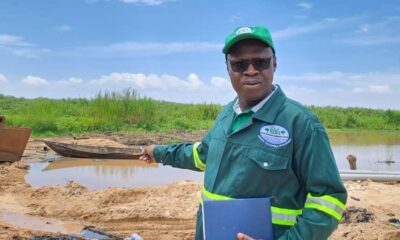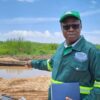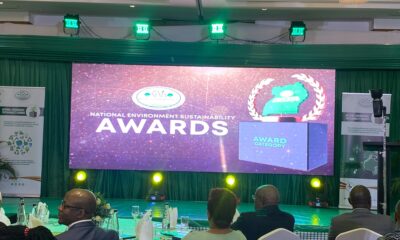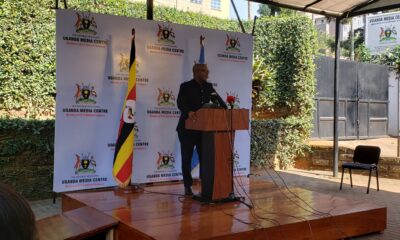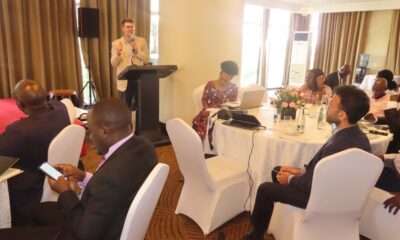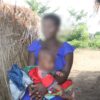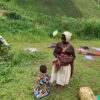Environment
A Lake on Its Deathbed; Who Can Save Lake Victoria?
By Sarah Biryomumaisho and Nalweyiso Barbra
In the bustling urban heart of Kampala and its neighbouring regions, countless Ugandans continue to rely on unfiltered water from Lake Victoria, despite evidence revealing the presence of fecal coliforms that render it unsafe for consumption.
Also known as Nalubaale, Lake Victoria is Africa’s largest freshwater lake shared by three East African countries; Uganda, Kenya and Tanzania. With a surface area of 68,800km, it is also the world’s second-largest freshwater body.
The lake supports one of the world’s most productive inland fisheries with the estimated total fish landings from the lake for the period 2011 to 2014 being about 1 million tons with a beach value increasing from about USD $550 million in 2011 to about USD $840 million in 2014.
However, for Ugandans, the lake produces more than fish. It provides water for drinking, cooking, washing and other purposes to millions of Ugandans residing in Kampala and surrounding areas. But scientists say the lake is being threatened by pollution, making water unsafe for both human and aquatic life.
Water pollution refers to the introduction of substances like chemicals, and microorganisms into water bodies at levels which make it unfit for different purposes including ecology, human consumption or recreation.
According to Dr. David Were, a lecturer and researcher in the Department of Environmental Management at Makerere University, pollution on Lake Victoria is mostly concentrated near urban areas with high intensities of pollutants.
Dr Were says the issue of pollution in Lake Victoria is a day-to-day challenge, mostly along the urban shores like Murchison Bay in Portbell in Kampala.
“The issue of pollution in the lake is growing day by day. It centers around traditional pollutants, especially nutrients. If you visit the lake at Murchison Bay, there is a green soup in the lake and this is usually an indicator of nutrient pollution, frequently that of nitrogen and phosphorus. When there is excessive input or discharge of the nutrients into the lake, they favour the growth of algae,” says Dr Were.
Our team of journalists visited different landing sites on Lake Victoria and we observed people washing clothes, and vehicles and bathing in the lake, yet according to the scientists, washing or bathing in the lake contributes to nutrient pollution, since detergent contains high levels of phosphorus.
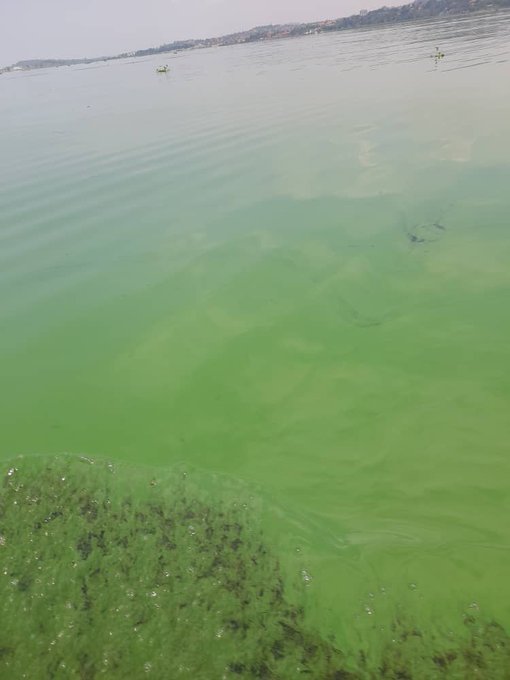
Algae in the water at Murchison Bay, Luzira
Dr. Were notes that nutrient pollutants make water unfit for its purpose especially human consumption and aquatic life including ecology. He explains that the fish have optimal conditions which they have to survive in the water; they have an optimal temperature, Ph (the measure of how acidic or basic water is) and requirements for oxygen. When pollutants are introduced into the lake, it alters the oxygen making it difficult for the fish to survive.
“Excessive input of nutrients in the lake motivates the growth of algae causing algae blooms consuming a lot of oxygen in the water column, becoming less and less as blooms intensify,” says Dr. Were.
Adding that “this cuts off the oxygen making the life not conducive to the fish. That is when we see the fish kills.”
Dr. Were explains that in December 2020 and early 2021, Uganda recorded massive fish kills mainly for Nile perch. They are mainly known as highly demanding oxygen fish, and any slight changes or decline of oxygen the fish will be stressed to the extent of fish kills.
The government of Uganda through the Acting Director for Fisheries Resource in the Ministry of Agriculture, Animal and Fisheries, Ms Joyce Ikwaput Nyeko, announced that the country had lost more than 100 tonnes of Nile perch (of fish) and about USD 400,000 in revenue.
Emerging Contaminants Exacerbating Lake Pollution
Scientists argue that while the issue of traditional pollutants is still not well addressed, we are now shifting from traditional pollutants to emerging pollutants, such as microplastics, pharmaceutical pollutants, and E-waste from the use of electric equipment such as computers, TVs, fridges and other electric equipment.
“We are having a lake with a cocktail of pollutants ranging from traditional pollutants which we have not addressed, to emerging pollutants. Currently, when you look at the greater Kampala area, most of the homesteads are not connected to the central sewage system. Only about 6% of homesteads are connected to the central sewage water treatment system. The rest of the homesteads dispose of their effluent through non-point sources which end directly into the lake. This is responsible for the high input of pollutants,” says Dr. Were.
Since these are new (emerging pollutants), they are not incorporated into the design of the existing water treatment plants. The current system cannot treat that kind of waste like removing plastic pollutants from the wastewater.
When one visits the lake, especially on a rainy day, it is rare to miss the sight of plastic pollutants along the lakeshore and also the passages (drainage channels and swamps) into the lake. Also, the encroachment on catchment areas like forests and swamps by humans has made it easier for the plastics to find their way into the lake.
“The most disturbing thing is point source pollution where there are resources coming from the catchment areas and therefore changing the environment where the fish stay,” says Dr. Anthony Tabu Munyaho, the deputy executive director of the Lake Victoria Fisheries Organization.
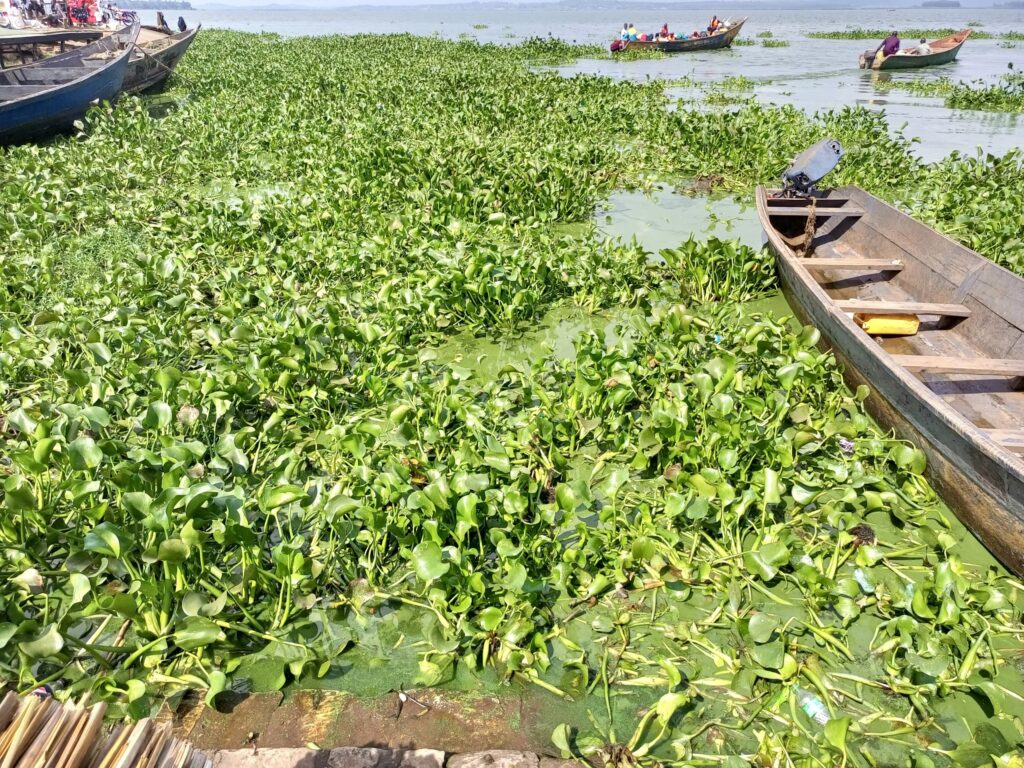
Water Weed and plastic water bottles make it difficult for boats to move at Ggaba Landing Site. Photo by Sarah Biryomumaisho
Unfortunately, when these pollutants get into the water, they degrade slowly and break into smaller particles that remain in the water and are suspended in the water colloids or in the segments. These pollutants take decades to break down by physical mechanisms. They can also be swallowed by fish, and through the food chain, the fish is also consumed by humans.
A 2015 research study by Great Lakes Research Journal, conducted in the Mwanza region of Tanzania, located on the southern shores of Lake Victoria, examined locally fished Nile perch and Nile tilapia and confirmed the presence of microplastics in 20 percent of fish in each species.
Lake Victoria has long struggled with declining fish stocks, attributed to overfishing as well as the emergence of invasive plant species, such as the water hyacinth, as well as the impacts of climate change. But increasingly, its pollution and the prevalence of microplastics are choking the lake and shutting off this economic engine for the three countries.
According to a research study carried out by Robert Egesa, a scientist at the National Fisheries Resources Research Institute (NaFIRRI) in 2020, the occurrence, abundance, distribution and chemical of microplastics within the size range 0.3-4.9mm, were assessed in the surface water of northern Lake Victoria. Lake surface transects in the sites were sampled using manta net and analyzed for microplastics.
All the microplastics were secondary in nature being derived from plastic materials utilized by the community,” says Dr Winnie Nkalubo, who spoke on behalf of the research team.
According to the study, the largest proportion (36 percent) of microplastic counts were of size 1 mm, which poses a threat to water quality and fisheries of the lake. Analysis of the chemical composition of microplastics indicated dominance by the low-density polymers; polyethylene and polypropylene across the microplastic types. These are produced by plastic products which melt and others that are solid. These include; plastic bottles, and bags among others.
Meanwhile, Dr. Were says the occurrence of microplastics derived from the degradation of large plastic debris implies that proper plastic waste management measures must be implemented in the communities operating on the lake and its vicinity in order to safeguard the ecosystem benefits derived from the lake.
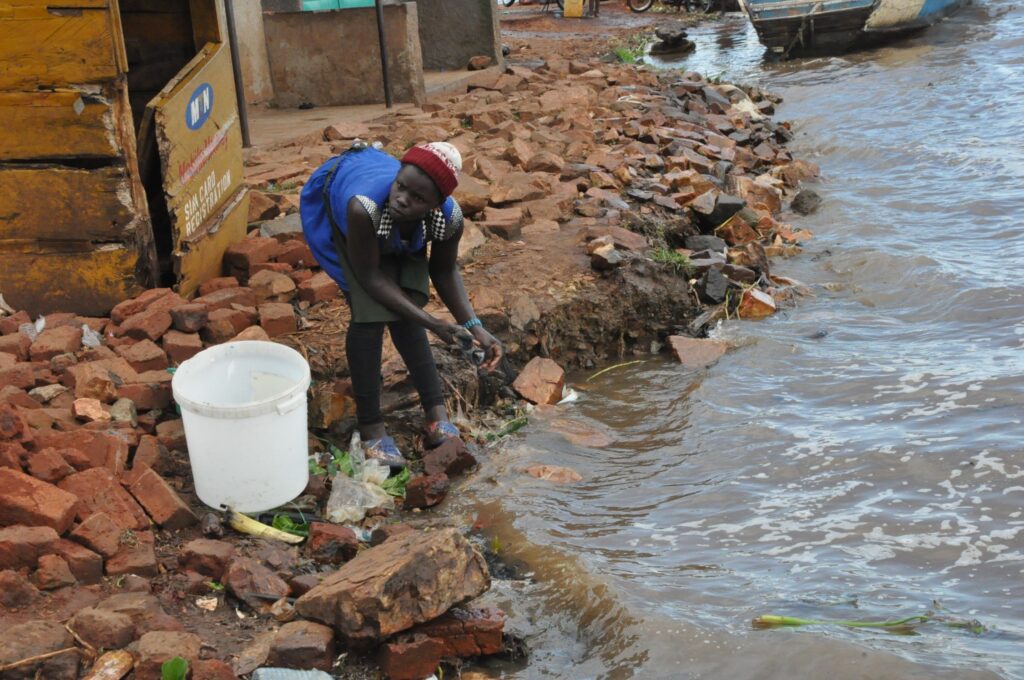
Woman washes clothing at Masese landing site in Jinja. Photo by Nalweyiso Barbara
Like any human being needs a clean homestead, Dr. Anthony Tabu Munyaho, the Deputy Executive Secretary of Lake Victoria Fisheries Organization, says even fish require clean water to stay safe.
“We together with our sister organizations including the Kenya Marine and Fisheries Research Institute, Tanzania Fisheries Research Institute and NaFIRRI in Uganda joint stock assessment to count actual fish in the lake, and we have seen changes, especially in the areas of polluted water,” he says.
Dr. Munyaho adds that there is fish density in the areas marked as the source of pollution and these are around major cities in the three countries. He names Murchison Bay in Uganda, Nyanza gulf of Kisumu, and Emin Pasha in the area of Kyoto, Tanzania, adding that there is now a big pollution problem coming in from agriculture practices around the lake.
The Sand Mining Tragedy on Lake Victoria
Sand mining is another cause of pollution on Lake Victoria contributing to fish scarcity, especially the Nile perch, Dr Munyaho reveals.
“Nile perch lays eggs in nests on the sand at the bottom of the water bodies. These are the breeding areas. When the sand is extracted, it goes with the nests and the eggs – tampering with the breeding process of fish,” he adds.
Our team visited Ggaba Landing Site in Kampala where some of the sand from Lake Victoria is sold. We were told that the sand is mined. Our requests to visit the site faced resistance from the sellers, who suspected that we were from law enforcement.
According to a study by the Institute for Security Studies, unregulated extraction, especially around Lake Victoria is destabilizing the area’s sensitive ecology.
“There is also evidence that it threatens local rural livelihoods, including both fishing and agriculture,” says the study.
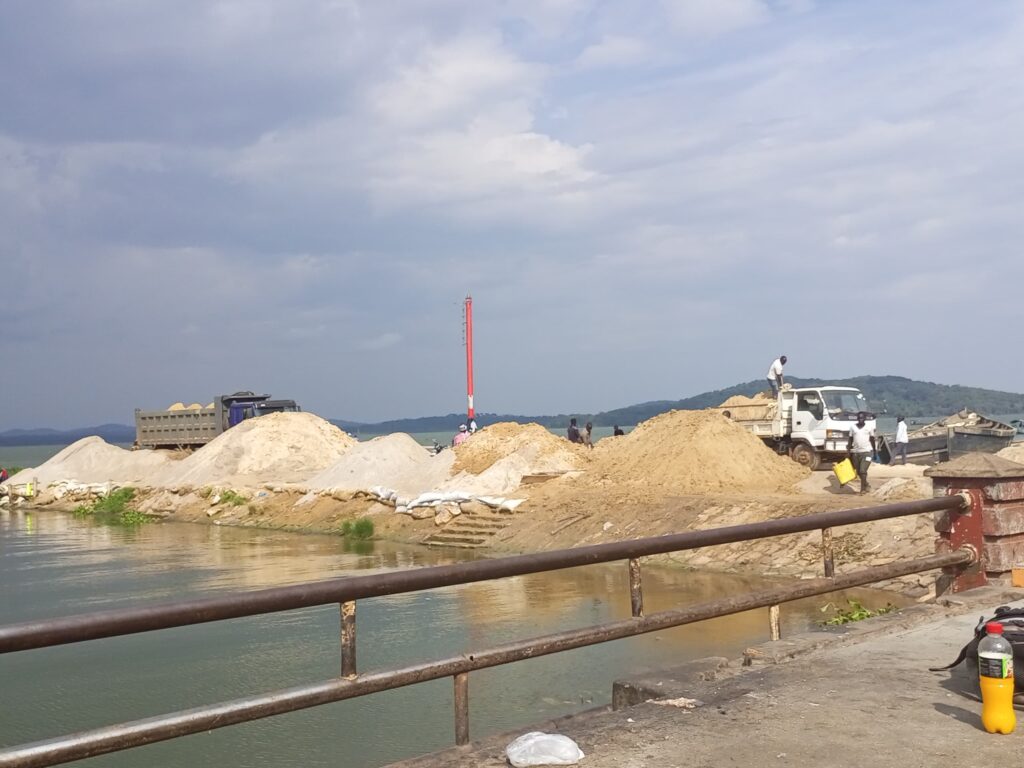
Trucks ferry sand from Ggaba landing site after it is delivered by boat. Photo by Sarah Biryomumaisho
The Cost of Treating Contaminated Lake Water
In Uganda, the National Water and Sewerage Corporation (NWSC) is the government agency mandated to supply safe piped water. The majority of the water that supplies Kampala City and the surrounding areas is abstracted and treated from the Ggaba landing site, on the shores of Lake Victoria.
Engineer Andrew Muhwezi, the senior manager of production at NWSC Ggaba Water Treatment Plant, says it takes them 24 hours of operation to treat water from the lake and make it suitable for human consumption. He however notes that due to pollution, water treatment is costly.
“We are having two abstraction points at Ggaba and Katosi. Today, the environment around Ggaba is largely built up and closer to Kampala City. From the inner Murchison Bay we registered some degree of pollution and had to shift our intake point in 2009 to about 500 metres off the shoreline”, he says.
He adds that the shifting of the water abstraction point was because it was becoming difficult to treat the water at the point where they used to get it due to high pollution by algae and other pollutants like plastics and heavy metals.
“We have a very modern laboratory and we are able to perform 100% of the tests we are supposed to perform. Also, as part of quality assurance, we take our tests to external labs to improve the validity of the results. Some of the results are not alarming like that of heavy metals, as many of them are below detection levels,” he narrates.
“We spend about USD $3,480,263 (UGX 13 billion) to USD $4,817,581 (UGX 18 billion) on chemicals and close to USD $9,634,691 (UGX 36 billion) on electricity. And, being that the levels of pollution at the abstraction point vary, the cost of Ggaba treatment plant is more expensive than that of Katosi treatment plant and if it wasn’t for pollution, we would be incurring less costs,” Eng. Muhwezi asserts.
We were given a full tour of the Ggaba water treatment plant and found out that water is filtered and treated before it is released to the final consumer. According to Eng Malambala who gave us a tour of the facility, all water is treated with chemicals like chlorine to make it safe for human consumption. He explains that when the water leaves their plants, it is treated and cleaned for human consumption. However, there is a possibility of it getting dirtied in transit due to dirty pipes and tanks that people use in their homes. This is why people are always advised to boil the water before drinking it.
Water is sampled 3 times a day, at 9:00 am in the morning, 3:00 pm in the afternoon and 3:00 am in the wee hours. The samples are collected directly from Lake Victoria and chlorine is added to kill the bacteria in the water.
The View of Independent Analysts
In order to prove that the water being consumed by Ugandans is safe, we carried out an independent water sample analysis by Les Rams Consult, an independent laboratory based in Bwaise, Kampala, to determine the safety of water from the lake for human consumption. We conducted field sampling of surface water from the upper, middle and lower part of Nakivubo channel, which drains into Inner Murchison Bay, the main source of drinking water for Kampala city. Nine water samples were collected from Kanyogoga Borehole, Kitintale Stream, and Portbell Murchison Bay on Lake Victoria (three each on three different days).
A litre of water was picked from each sampling point and transported to this laboratory for analysis. The analysis parameters included biological oxygen demand (BOD), chemical oxygen demand (COD), pH, electronic conductivity (EC), oil and grease, turbidity, total phosphorus, total nitrogen, heavy metals (lead, cadmium and mercury) and faecal coliforms.
The analytical results generally indicate that the water is unsafe because of the presence of Faecal coliforms. This was confirmed in all the samples. Faecal coliform counts, which include bacteria from human and animal waste, give a general indication of the sanitary condition of a water supply.
Analyzing the results, Dr. Were noted that Faecal coliforms themselves do not pose any danger to humans or animals. However, once they are detected, they indicate the presence of other disease-causing bacteria such as that which causes Typhoid, Dysentry, Hepatitis A and Cholera.
[Dataviz: Feacal coliform Test results
Our results are similar to those of a study by the Ministry of Water and Environment carried out in 2005 called Water Quality and health conditions in Lake Victoria region, Uganda. https://www.mwe.go.ug/sites/default/files/library/Chapter%2011%20WATER%20AND%20HEALTH.pdf
The aim of the study was to examine the trend of diseases and health risks in the riparian communities and suggest intervention measures.
“Faecal coliform counts in water samples were analyzed for indication of faecal contamination. The coliforms were generally very high in most of the sampling sites, indicating that the waters were highly contaminated,” says the study.
Another study conducted by Swiss Tropical and Public Health Institute and the Uganda National Council for Science and Technology, with samples collected in 2013, also found “much higher microbial contamination than previously reported for Kampala.”
“[This] might underline a decrease in the natural treatment function of the Nakivubo wetland… Flooding events of the Nakivubo channel and wetland may also contribute to the pollution of protected springs,” the study reported.
Even though coliform values were lower in Murchison Bay, the presence of the bacteria at all indicates that “the source for drinking water in Kampala is likely to be polluted by pathogenic bacteria, viruses and protozoa organism, which may survive the treatment processes.”
The 2005 researchers added that the riparian communities source their water for domestic consumption mainly from the lake. “The wet seasons had significantly higher coliform counts than the dry seasons for all lakeshore sites. This seasonal variation in coliform counts correlates positively with waterborne disease incidences that are higher in the wet season. The most prevalent diseases in the landing sites included malaria, dysentery, diarrhoea and bilharzia. Cases of cholera, skin-related infections and influenza, were also observed.”
This study also found that the human relation with polluted water along the shores of Lake Victoria is based on the fact that there are basically two relevant sources of water influencing the health of the lakeshore population: the lake water itself and the on-shore drinking water sources in the communities (rivers/streams, wells, boreholes and springs, where such exist).
According to the researchers, the other sources of water which influence human health, such as floodwater in and around the communities during the rainy season, also used for domestic purposes are significant but temporary. The interactions between large water bodies and human beings having serious health impacts are mainly: swimming/bathing, drinking and eating (poisoned or contaminated fish).
Despite the small number of studies conducted on waterborne parasitic diseases in eastern Africa over the past seven decades, available information highlights that the prevalence of important parasitic diseases is still high in recent years. In the eastern Africa region, the proportion of populations using improved drinking water sources are <50% to 75% while <50% of the populations have improved sanitation facilities (WHO, 2015). This may account for the observed high prevalence of waterborne parasitic diseases. Thus improving water and sanitation facilities would reduce the burden of these diseases.
https://www.ncbi.nlm.nih.gov/pmc/articles/PMC7508703/
According to the 2022 water sampling test commissioned by InfoNile, values for Chemical Oxygen Demand (COD) were also above both the national standards and the East African Effluent Discharge Standards.
Chemical Oxygen Demand (COD) is the amount of oxygen needed to oxidize the organic matter present in water. The higher the COD value, the more serious the water pollution.
According to the InfoNile water sampling, most other water quality parameters lie within acceptable ranges.
Some parameters, such as Biochemical Oxygen Demand, Phosphorus, Lead and Cadmium, appeared to be around the same values or had slightly improved from the 2013 sampling.
Nitrogen, however, had slightly increased. Nitrogen, which stimulates the growth of algae that depletes oxygen, can come from agricultural fertilizers, wastewater, and animal waste.
[Dataviz: Comparison of water analysis results from Lake Victoria (Uganda): 2013 and 2022
With the increase in population mainly in cities and urban areas around the lake, the problem of pollution is expected to persist for many more years.
This is partly led by encroachment on forests and wetlands to inhabit humans. A 2015 study published in the Journal of Water and Health analyzed water quality in four forest reserves within 50 kilometres of Kampala that act as a buffer for water draining into Lake Victoria.
“In the current study, the data indicate that each forest reserve has at least one site with particularly depleted water quality. In the smaller forest reserves of Zika and Kitubulu this is particularly alarming since the land area is interconnected by groundwater, and thus directly contributes surface water runoff to Lake Victoria. The largest forest in this study, Mabira Forest, had the worst water quality of all 17 sites. This is alarming, as this tributary leads directly to the source of the Nile River in Jinja,” the study found.
Another persistent threat is the continued use of non-degradable plastics, which range from bottles to straws and polythene bags. While locals admit to knowing that they are dangerous, many confess to using them because they do not have any other option.
Polythene bags commonly known as ‘kavera’ are the largest contributor to plastics pollution in Uganda. The government has on several occasions put a ban on its use but enforcement has failed.
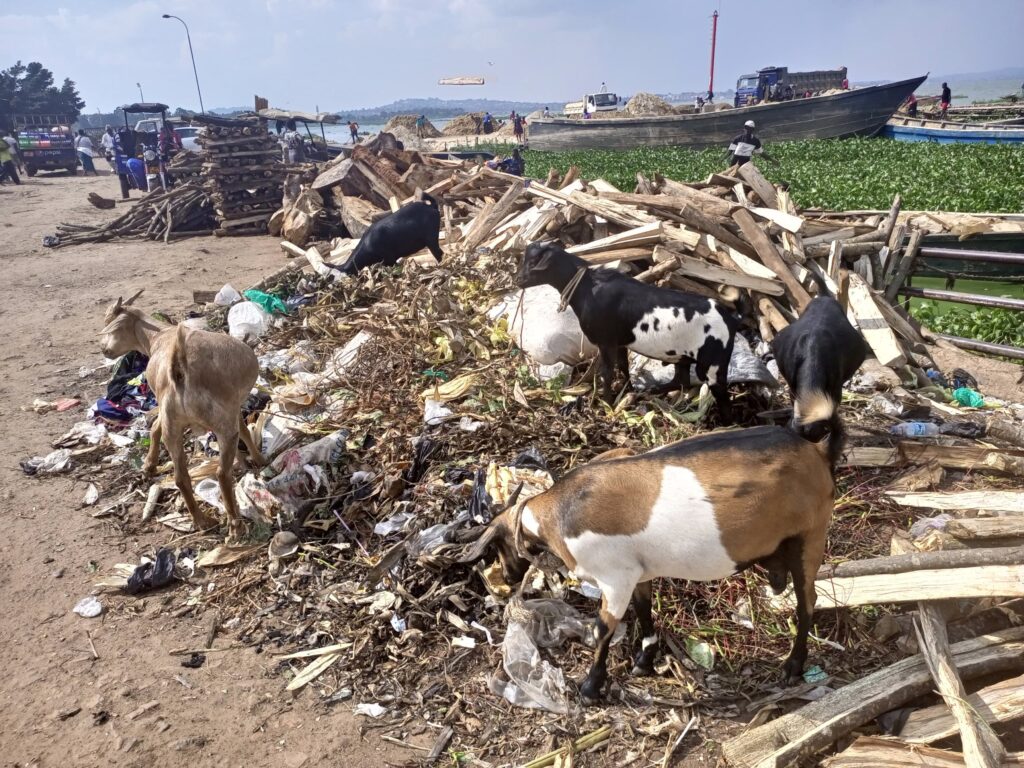
Goats feed from a pile of garbage filled with plastics at Ggaba landing site. Photo by Sarah Biryomumaisho
Margaret Akankwasa has been selling fried fish at Ggaba Landing site for the past two decades. She observes a decline in fish catches compared to when she started, even during peak fishing seasons.
“Fish are abundant in the rainy season, but their catch reduces during the dry season due to the heat. When it’s windy, fishermen fear for their safety, so catches also decrease,” explains Akankwasa.
Previously priced at 2,000 shillings, a unit of fish now costs between 8,000 and 10,000 shillings. Akankwasa and her fellow vendors are well aware of the plastic pollution affecting the lake and its hazardous implications. Researchers from Makerere University educated them about the dangers of dumping plastics into the lake.
Despite this knowledge, Akankwasa laments that the community remains resistant to change. She believes enforcement is necessary, suggesting that if people faced legal consequences for polluting the lake, others would take heed. Over the years, the National Environment Management Authority (NEMA) has conducted educational sessions on lake conservation, yet many ignore the advice, even warnings that consuming fish that feed on plastic waste might lead to cancer.
Akankwasa’s livelihood revolves around fish sales, providing for her family’s needs and educating her children over the past two decades. Her journey began with selling 15-30 small fish daily, but she now deals with at least 50 kilograms of fish per day.
Ssempa Matovu Ssalongo shares a similar story. He has sold fish at Ggaba for two decades, engaging with fishermen directly and focusing on fresh fish. Around five years ago, they started noticing a decline in fish numbers. Ssalongo attributes this to harmful fishing practices such as overfishing and catching immature fish, which persists despite UPDF enforcement efforts on Lake Victoria.
Ssalongo emphasizes that pollution also contributes to the dwindling fish populations. Plastics, including bottles and bags, are discarded into the lake, occupying the areas where fish normally hatch, near the shores. As these spots become inhospitable, fish abandon the hatching process, leading to a reduction in their numbers.
He laments the lack of concern among younger individuals who disregard warnings about plastic pollution. He also highlights sand mining as a factor impacting fish populations. Consequently, they now source fish from Lake Kyoga and sell them at Ggaba landing site on Lake Victoria.
Ssalongo never anticipated a time when fish would be transported from Lake Kyoga to sustain Lake Victoria communities. The closure of Lake Kyoga to the public has allowed it to recover and minimize pollution levels and it is now feeding communities along the Lake Victoria shores.
The duo maintain that enforcement is the best way to deal with plastic pollution on the lake.
In April 2015, the cabinet constituted an inter-ministerial committee consisting of the Ministries of Trade, Water and Environment, Finance and Agriculture as well as the National Environment Management Authority, Uganda Marketers Association and Kampala City Traders Association, to process the implementation of the ban on polythene bags as stipulated in the Finance Act of 2009, and re-echoed by President Yoweri Museveni.
However, on 2nd October 2018, the then-NEMA Executive Director Tom Okurut told legislators on the Natural Resources Committee of Parliament that the authority was directed to continue the ban on importation, local manufacturer, distribution and use of plastic carriers below 30 microns, as it waited for guidance from Cabinet on how to handle other types of plastic materials that are above 30 microns.
Appearing before the same committee on 3rd October 2018, the then-Minister for Trade, Amelia Kyambadde, advised against an immediate ban on ‘kavera’, but rather a gradual phase-out of production and use of the plastic carrier bags. She argued that an immediate ban on plastic carrier bags below 30 microns doesn’t present a clear phase-out strategy by NEMA to handle compensation of workers who could be laid off because of the decision.
“The decision to totally ban the manufacture, importation and use of plastic carrier bags was rushed and there were limited stakeholder consultations,” said Kyambadde at the time.
The current NEMA Executive Director, Barirega Akankwasah, says that it is impossible to measure the 30 microns with one’s naked eyes, making it difficult to enforce the law. With the renewed call by the Cabinet backed up by the President, Barirega believes the law banning the use of plastics will now pass.
“Cabinet resolved to have a total ban on kavera. This means we are going back to Parliament to defend the move, amend the law (National Environment Act) and cause the total ban. This time it will pass because the President has also added his voice,” said Barirega.
In August 2021, the government through the Cabinet renewed the call for a total ban on the manufacturing, use, and importation of kavera. Beatrice Anywar, the State Minister for Environment, noted that this time around, nothing will frustrate the implementation.
The failure to implement the ban has been attributed to several reasons including corruption, politics, lack of sensitization of the masses and lack of suitable alternatives. Until such laws are put in place and equally enforced, the use of plastics remains a threat to Africa’s largest lake.
This story was supported by InfoNile with funding from JRS Biodiversity Foundation; and additional reporting by Annika McGinnis, Ruth Mwizeere, Primrose Natukunda, Innocent Nabaasa and Sarah Natoolo.



